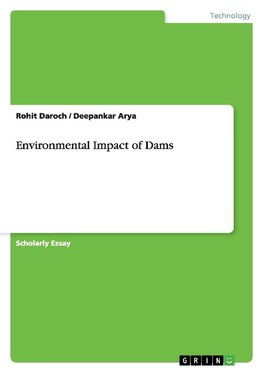
-
 Anglický jazyk
Anglický jazyk
Environmental Impact of Dams
Autor: Rohit Daroch
Scientific Essay from the year 2013 in the subject Environmental Sciences, grade: 10.0, Indian Institute of Technology, Delhi, language: English, abstract: According to WWF: . Worldwide the total amount of water stored in dams is 3-6 times more than that... Viac o knihe
Na objednávku
14.76 €
bežná cena: 16.40 €
O knihe
Scientific Essay from the year 2013 in the subject Environmental Sciences, grade: 10.0, Indian Institute of Technology, Delhi, language: English, abstract: According to WWF: . Worldwide the total amount of water stored in dams is 3-6 times more than that contained in rivers. . The wetlands area during the 20th century has decreased by over 50%. . Out of the 10,000 recorded freshwater species more than 20% have either become extinct, threatened or endangered in recent times.
These facts are enough to justify the tremendous impact on environment dams are having. Large scale projects like dams are often floated as important and necessary means of economic development. But this development comes at some or the other cost. Cost to the environment, development and society. So what are dams really for? . Water supply for the general public for domestic uses as well as irrigation which is imperative for our agrarian Indian society. . Hydroelectric power generation. India is the 7th largest producer of hydroelectric power with 114 Tetra-watt hours. It produces 3.3% of the world total. . Dams impede the turbulent and sudden flow of water to prevent floods.
Well that is what they are for and granted many of them achieve the above given purposes but they are subject to widespread criticism and debate. Several vehement national and international movements have brought into light the severe problems associated with them. Dams have been criticized for disturbing natural water flows, affecting deposits of nutrients as well as lifecycles of species that depend on freshwater habitat. Reductions in water quantities can increase salinity and make the water unusable for drinking and irrigation. The transport of sediments that are crucial for natural cycles is also affected. This may cause flood risks, lower groundwater tables and in turn affect entire ecosystems. With that said we must point out that dams do not always have a negative impact on habitats. E.g. once reservoirs become established they can become sites where birds can thrive. There are cases where dam projects have taken up significant compensation for the environmental damage they had caused during their initial phases, but these cases are few and far between. In this report, we take up the issue of impact of dams from three different perspectives which we believe are best suited for such a topic: - Economics, Population and Risks and Hazards. We first present them individually and give a brief analysis of each perspective then we present a comprehensive and thorough conclusion at the end.
- Vydavateľstvo: GRIN Verlag
- Rok vydania: 2014
- Formát: Paperback
- Rozmer: 210 x 148 mm
- Jazyk: Anglický jazyk
- ISBN: 9783656687436












